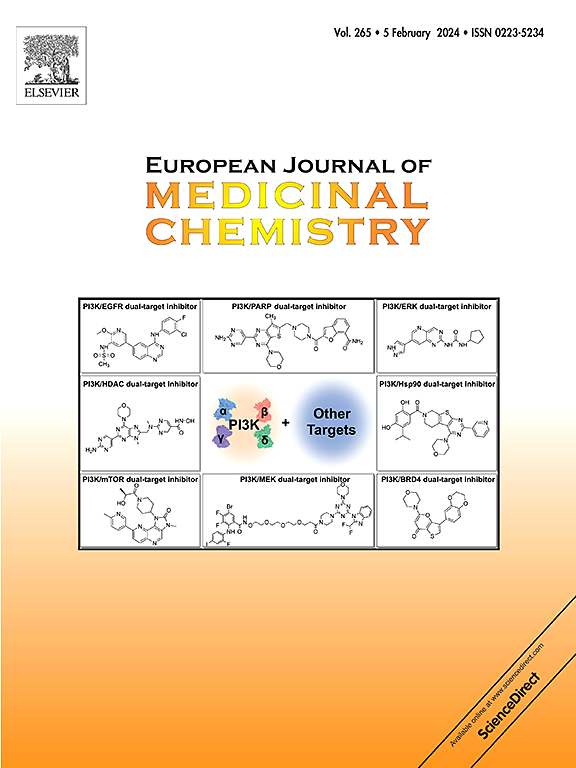Uncoupling toxic NO signaling: Progress, challenges, and therapeutic promise of disrupting the PSD-95/nNOS protein–protein interaction
IF 5.9
2区 医学
Q1 CHEMISTRY, MEDICINAL
引用次数: 0
Abstract
The interaction between postsynaptic density-95 (PSD-95) and neuronal nitric-oxide synthase (nNOS) forms a signaling hub that couples N-methyl-d-aspartate receptor (NMDAR) calcium influx to bursts of neurotoxic nitric oxide. Disrupting this protein-protein interaction (PPI) offers a strategy to suppress pathological NO production while sparing normal synaptic transmission—an advantage unattainable with channel blockers or active-site nNOS inhibitors. Over the past two decades, cell-penetrant peptides such as nerinetide (Tat-NR2B9c) have validated the target from rodent stroke models to phase-III clinical trials, while bivalent constructs achieve low-nanomolar affinity and extended brain exposure. Parallel medicinal-chemistry campaigns have delivered multiple small-molecule scaffolds (IC87201, ZL006, SCR-4026, PCC-0105002) that cross the blood–brain barrier, disrupt the complex at low-micromolar concentrations, and demonstrate efficacy in ischemic stroke, neuropathic pain, and neuropsychiatric paradigms without the liabilities of NMDAR antagonists. A comprehensive assay cascade—from NMR and AlphaScreen to in-situ proximity ligation and in-vivo PLA—now links molecular binding to functional outcomes. Formulation advances (PEGylated liposomes, pH-responsive polymers) and non-invasive routes (intranasal, focused-ultrasound BBB opening) further enhance brain delivery. Remaining challenges include achieving sub-micromolar small-molecule potency, ensuring long-term circuit selectivity, and scaling complex peptide or nanocarrier manufacturing. Structural elucidation of ligand-bound complexes, covalent and bivalent chemistries, and AI-guided design promise to surmount these hurdles. Collectively, the evidence positions PSD-95/nNOS disruption as a versatile, clinically achievable approach for mitigating excitotoxic and nociceptive pathology and sets the stage for first-in-class therapies that uncouple toxic NO signaling without silencing healthy synapses.


解偶联毒性NO信号:破坏PSD-95/nNOS蛋白-蛋白相互作用的进展、挑战和治疗前景
突触后密度-95 (PSD-95)和神经元一氧化氮合成酶(nNOS)之间的相互作用形成了一个信号中枢,将n -甲基- d -天冬氨酸受体(NMDAR)钙内流偶联到神经毒性一氧化氮的爆发。破坏这种蛋白-蛋白相互作用(PPI)提供了一种抑制病理性NO产生同时保留正常突触传递的策略,这是通道阻滞剂或活性位点nNOS抑制剂无法实现的优势。在过去的二十年中,细胞渗透肽如nerinetide (dat - nr2b9c)已经从啮齿动物中风模型验证到iii期临床试验,而二价构建物具有低纳摩尔亲和力和延长脑暴露时间。平行的药物化学运动已经提供了多种小分子支架(IC87201, ZL006, SCR-4026, PCC-0105002),这些支架可以穿过血脑屏障,在低微摩尔浓度下破坏复合物,并且在缺血性中风,神经性疼痛和神经精神范式中显示出有效性,而没有NMDAR拮抗剂的副作用。从NMR和AlphaScreen到原位接近连接和体内pla的综合分析级联现在将分子结合与功能结果联系起来。配方的进步(聚乙二醇化脂质体,ph响应聚合物)和非侵入性途径(鼻内,聚焦超声血脑屏障打开)进一步增强了脑递送。剩下的挑战包括实现亚微摩尔的小分子效能,确保长期的电路选择性,以及扩大复合肽或纳米载体的生产规模。配体结合复合物、共价和二价化学的结构阐明以及人工智能指导的设计有望克服这些障碍。总的来说,这些证据表明PSD-95/nNOS破坏是一种通用的、临床可实现的减轻兴奋毒性和伤害性病理的方法,并为在不沉默健康突触的情况下解耦毒性NO信号的一流疗法奠定了基础。
本文章由计算机程序翻译,如有差异,请以英文原文为准。
求助全文
约1分钟内获得全文
求助全文
来源期刊
CiteScore
11.70
自引率
9.00%
发文量
863
审稿时长
29 days
期刊介绍:
The European Journal of Medicinal Chemistry is a global journal that publishes studies on all aspects of medicinal chemistry. It provides a medium for publication of original papers and also welcomes critical review papers.
A typical paper would report on the organic synthesis, characterization and pharmacological evaluation of compounds. Other topics of interest are drug design, QSAR, molecular modeling, drug-receptor interactions, molecular aspects of drug metabolism, prodrug synthesis and drug targeting. The journal expects manuscripts to present the rational for a study, provide insight into the design of compounds or understanding of mechanism, or clarify the targets.

 求助内容:
求助内容: 应助结果提醒方式:
应助结果提醒方式:


